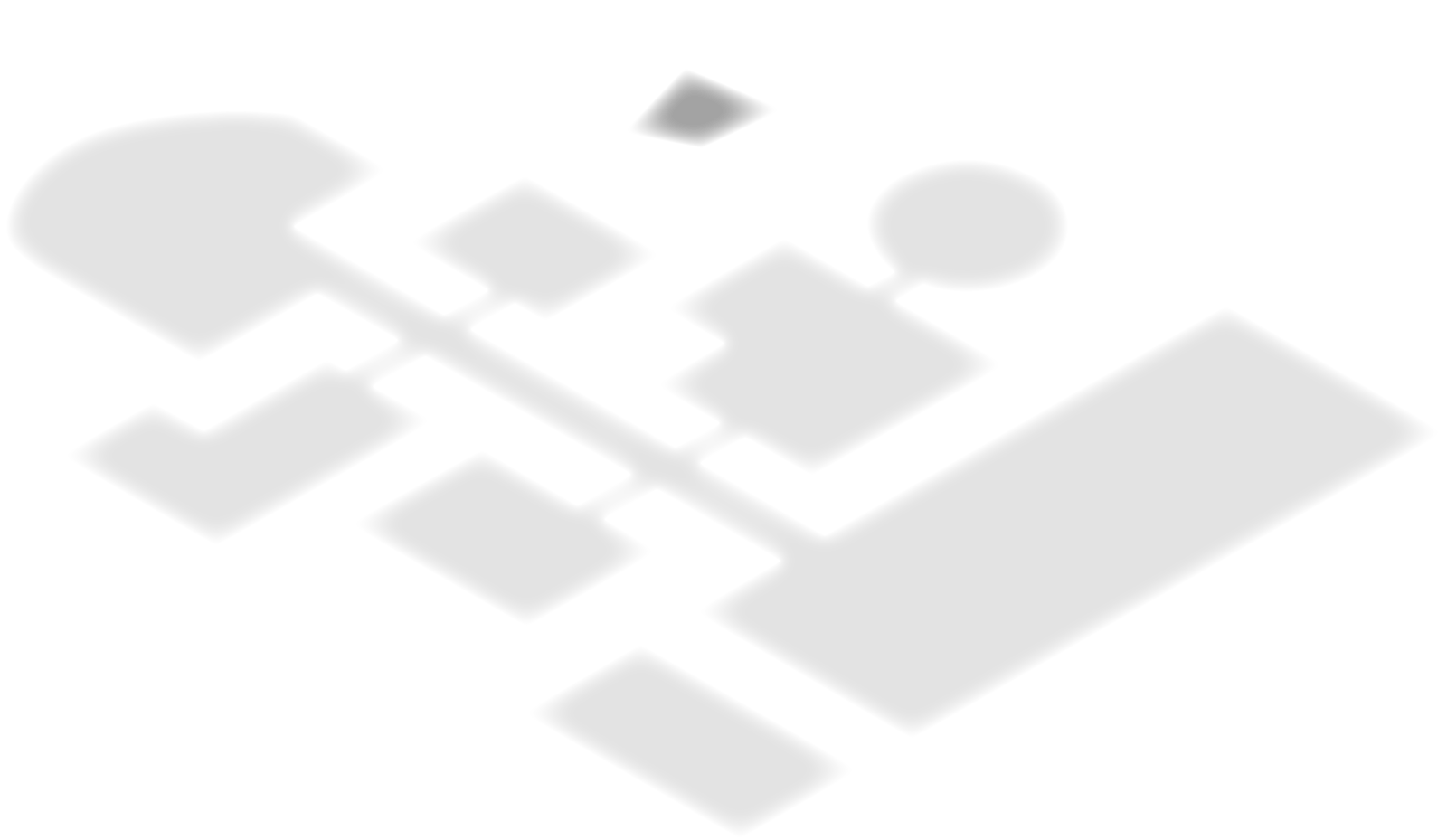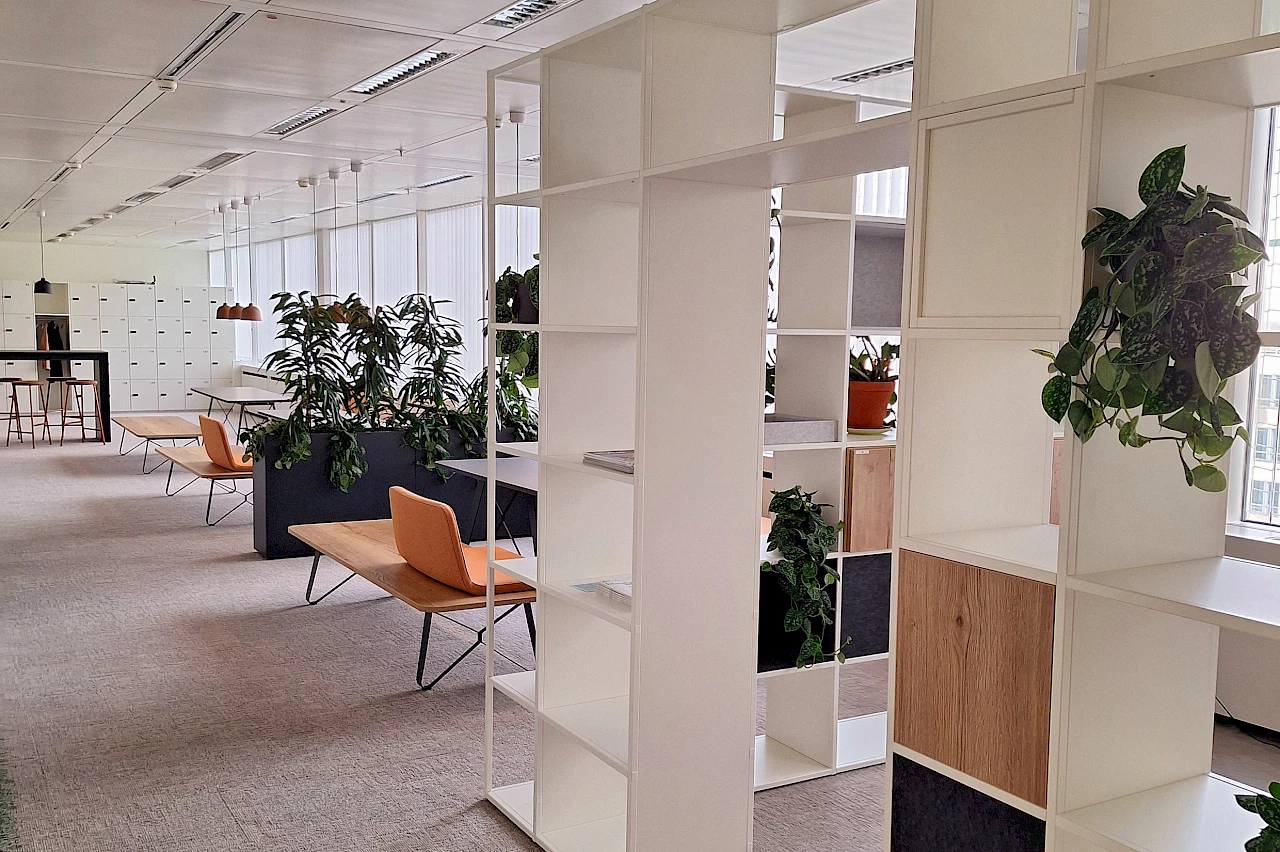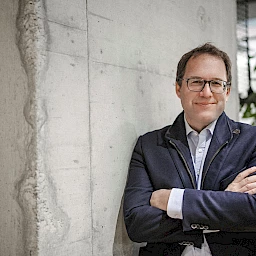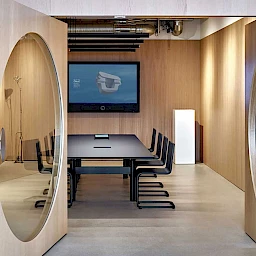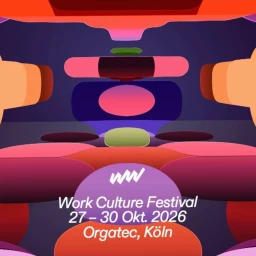Koelnmesse has completely redesigned its office space in the Marketing Communications department. The result is a modern working environment that promotes openness, creativity and interaction, while at the same time focussing on sustainability. The IBA Forum editorial team spoke to representatives of Koelnmesse about the background, aims and experiences of this transformation process.
What distinguishes the new working environments?
The new spaces combine open collaboration with opportunities for retreat—a real “best of both worlds”. They are flexible, modern and create space for creativity.
Why was the working environment redesigned?
There were many reasons behind the decision to reorganize our working environments, which is part of a larger transformation process that promotes the agile work processes of the future. Our new working environment needed to be flexible, project-orientated and cost-effective while at the same time conserving resources. It enables mobile working that is independent of time and place, and links analogue and digital working even more closely together. It was also important for us to create optimal conditions for our performance, customer focus and innovative strength. We needed spaces that promote the speed and efficiency of our decisions and processes, improve our communication and internal networking and strengthen interdisciplinary collaboration and team spirit. In addition, the new environment should be fun, inspiring and stimulate our creativity. It is a modern place of interaction and identification that creates transparency and open co-operation while showing the outside world what Koelnmesse stands for.
How is the company’s identity reflected in the new spaces?
Koelnmesse stands for openness, interaction and team spirit. This is exactly what the rooms reflect. Our values such as collaboration and flexibility also characterize the workplace. With the new working environment, Koelnmesse is making its vision of a future-orientated, flexible and sustainable company with a clear focus on its customers and a modern, attractive employer visible and tangible. A trade fair is about meeting and exchanging ideas. We have transferred this principle to the office. The areas are real meeting places that exude the character of an event and the atmosphere of a trade fair. At the same time, they build a bridge to our own formats— the chairs, for example, come from a long-standing ORGATEC exhibitor. Desks, shelves, sideboards, planters and even the kitchenette were also supplied by partners who are regularly represented at ORGATEC. Overall, the design is strongly inspired by our furniture and interior trade fairs idd cologne, imm cologne, interzum and ORGATEC. The office thus also becomes a showroom, a stage for New Work and a living example of what we make visible at our events.
What kind of spaces are available?
The principle of our new working environments is demand-orientated: the utilization of the areas is always activity-oriented. There are different types of space available for every task—ranging from open-plan team workstations, quiet focus areas and telephone booths to lounges, kitchens and retreat spaces. All the resources are used on a sharing basis, so there are no permanently assigned workstations. Single rooms that can be flexibly reserved as needed are also available. In addition, the areas have a modular structure and are divided into quiet and communication zones. Project-related work opportunities can also be reserved for specific periods of time. The result is a multi-space concept that enables concentrated work as well as spontaneous dialogue or creative workshops.
What was the guiding principle behind the transformation of the working environments?
The change in the working environments in our New Work area was based on the guiding principles of strengthening flexibility and collaboration and creating space for interaction. The aim was to develop an environment that does justice to different working styles and enables both concentrated work and open collaboration. Activity-based working is at the heart of the concept—various workspaces are available according to the task at hand. This is complemented by the flexible booking of workstations, which supports agile utilization of the areas. This creates an environment that supports encounters and dialogue as well as productivity and individuality.
How will hybrid working be realized in the new spaces?
Clean desksharing, modern conference technology, writable magnetic walls and flexible team zones make it easy to work together efficiently both virtually and on site. The concepts were customized for our area. Planning coordinators, who were elected by the individual department teams, took into account the needs of the individual functions. This has created the modern working environments that we know from ORGATEC—spaces that not only enable efficient collaboration but also actively support it.
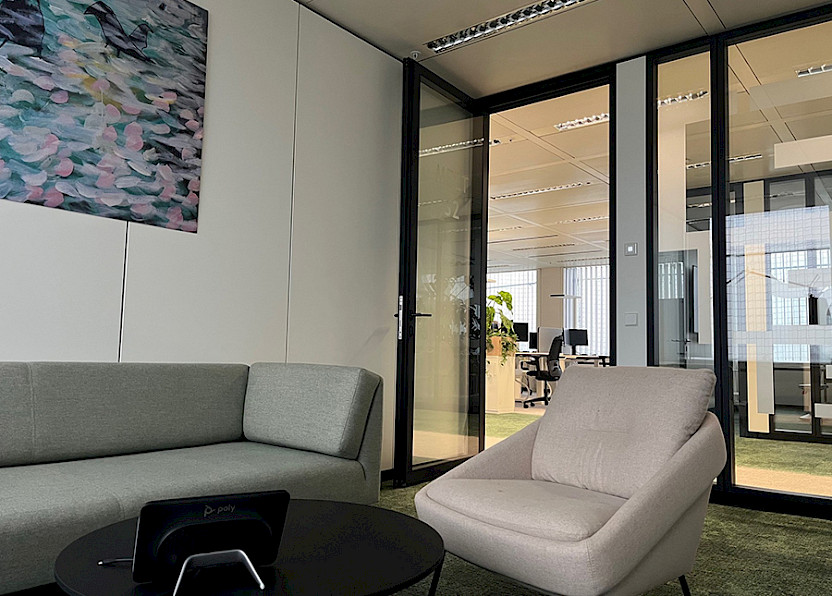
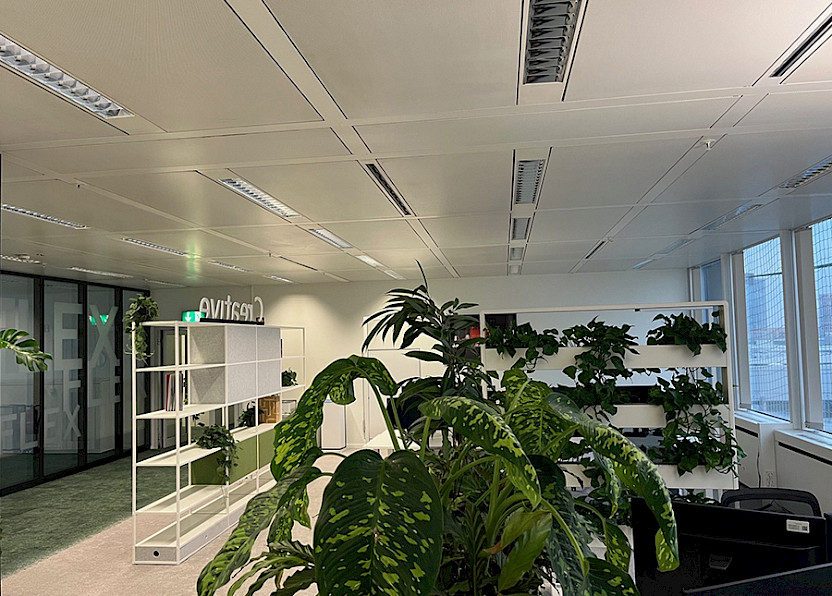
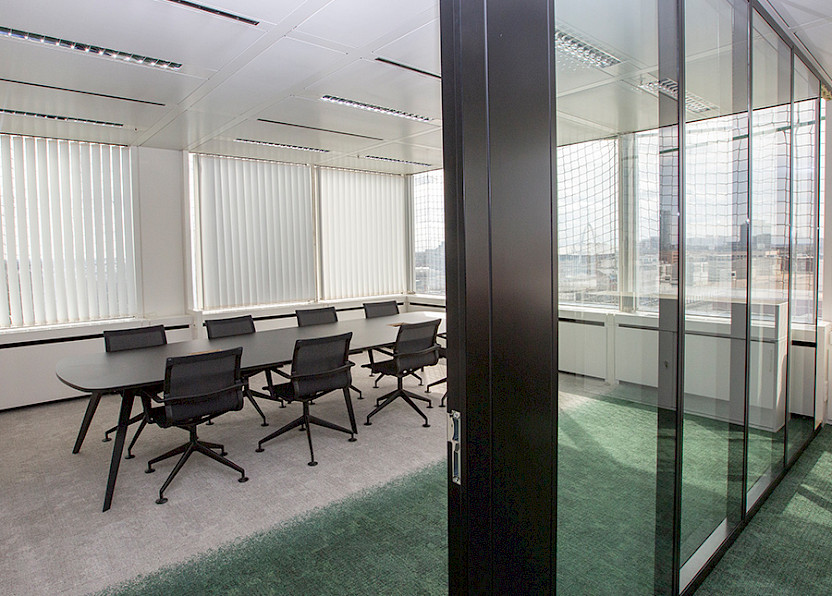
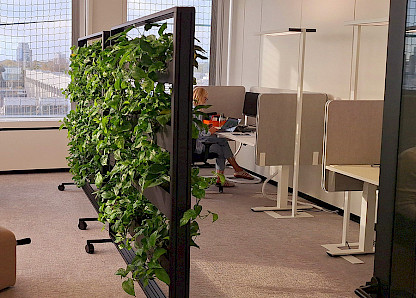
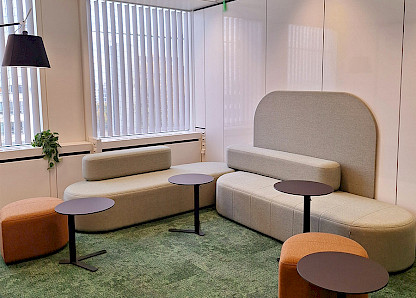
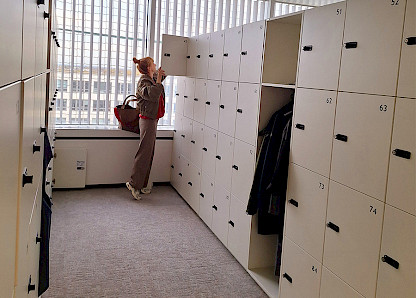
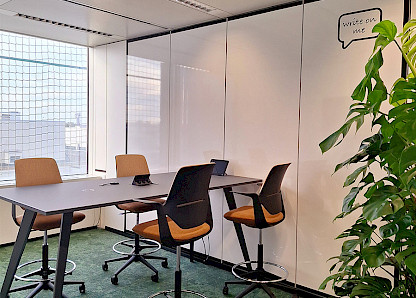
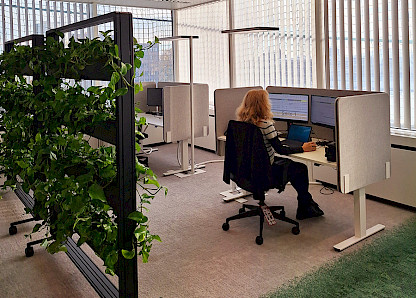
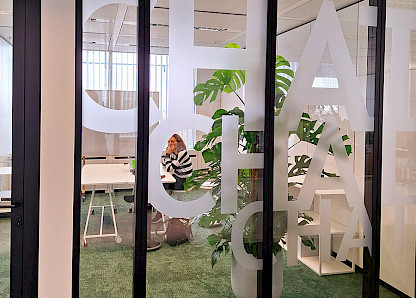
How important was sustainability in the design of the working environments?
Very. From the carpeting and furniture to the partition walls—all of the elements were consciously selected according to ecological criteria. We’re using carpets made from recycled materials, durable furniture from resource-conserving production and modular partition walls that can be flexibly moved, added to or converted. We have also paid attention to efficient technology and maximizing the service life of the furnishings. The many plants in the office provide a special highlight. They not only improve the indoor climate and the acoustics but also bring nature into the building and make sustainability a tangible part of everyday life.
How do the new working environments contribute to employer attractiveness?
The modern offices clearly contribute to the employer branding. New colleagues immediately realize during onboarding that this is a place where we’re working on the future. Thanks to our proximity to leading trade fairs such as ORGATEC, we can also show that we not only offer a platform but also authentically put the topics of New Work, interior design and modern working environments into practice in-house.
How are the new offices being received by the employees?
The response to the new offices has been positive throughout. The flexibility, which makes it possible to respond individually to different work requirements, is particularly emphasized. Many employees appreciate the newly created meeting places and interaction areas that promote dialogue—not only within their own teams, but also across departments—and are perceived as a real benefit. Another frequently mentioned point is the high-quality equipment, which is seen as an expression of appreciation. Employees not only feel that they are taken seriously, but also feel more motivated and more comfortable in their working environment. A surprising—and thoroughly positive—experience was seeing how well the new spaces enable quiet and focussed working. Despite the open design, there are no distractions—something that many did not initially expect. This tranquillity is perceived as a major plus point and shows that the mix of focus and collaboration areas has been optimally implemented.
How intensively and in what way are the various rooms actually being used?
Team zones and lounges are particularly popular, and at the same time we’re seeing more frequent presence in the office because it’s simply fun to be there. It’s also exciting for us that many of the concepts that we know from ORGATEC—such as flexible workspaces and modular furniture—have been very well received in-house. This shows how close the trade fair world is to our own work.
How flexibly are you positioned for future growth or new requirements?
The spaces are modular so that we can adapt and grow at any time. Flexibility remains a key principle. For example, we found that significantly fewer focus workstations—which tend to create a quieter working atmosphere—were needed, but we also required more team workstations than we had expected. We were able to react quickly and make adjustments.
Welche Learnings habt ihr aus dem Prozess mitgenommen und gibt es Empfehlungen für andere Unternehmen in ähnlichen Transformationsphasen?
Benefiting from the experience of others was one important lesson from our process. Another department had already gone through similar changes, and their insights helped us to recognize typical challenges early on and adopt successful approaches to them. This ability to look beyond our own area has been crucial in helping us to organize our transformation more efficiently. It was also very important for us to involve the teams in the change process right from the start. This enabled us to obtain valuable feedback and increase acceptance of the new working environment. In the end, the step towards a New Work environment naturally required openness and the courage to question traditional working methods and implement new concepts. Not everything has to be perfect right from the start, but it pays to be innovative.
Our recommendation to other companies is therefore to learn from the experience of others, give the employees an active voice in the design process and make courageous decisions that go beyond what you’re used to. Open dialogue—whether internally between departments or externally with other companies—can provide valuable impetus and pave the way for sustainable solutions. Change offers an enormous opportunity if it is understood as a joint development. Use this opportunity to transform not only workspaces but also the corporate culture in a sustainable way!
Thank you for talking with us.

